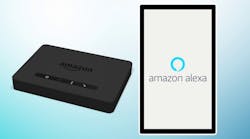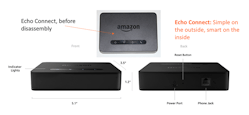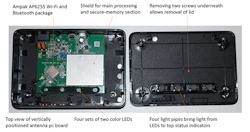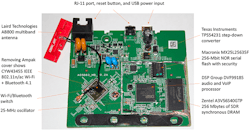Alexa will be everywhere in 2018, starting with Amazon’s pervasive booth, panel, and tutorial presence at next week’s CES 2018. In among the many microphone and speaker-equipped devices on display will be the Echo Connect, which has neither microphone nor speaker, but which will nonetheless bring ye olde households into the new age of voice-enabled dialing.
The Echo Connect was announced in September and is a clear nod to the reality that not all landlines will be ditched in favor of cellphones anytime soon. In response to this realization, and in a clear attempt to make Alexa more useful to geeks and luddites alike, Amazon designed the Echo Connect to integrate into a landline service to allow users to call contacts simply by asking Alexa.
This sounded interesting, so when it became available over the holidays, Electronic Design got hold of one and took a look inside. It turns out that what seems so simple and elegant on the outside was made useful by a good deal of advanced technology and capabilities on the inside.
The Echo Connect Really Does Connect
Landline users are caught between two worlds. There’s the usefulness and portability of cellphones, including voice-activated dialing. Then there’s the stability, reliability, familiarity of landlines, but they’re either in a fixed location, or users have to go hunting for one of the cordless handsets that are ringing, muffedly, under a cushion, somewhere. There’s also the concern about having 911 access should the cellphones become inoperable.
The reasons are many for landlines, whether they be classic telecom voice lines, or newer voice-over-IP internet connections. So, for $34.99, the Echo Connect provides a small black box that connects to a landline and ropes in any Alexa voice- and speaker-enabled device in the home as the ears and mouth for the voice-controlled landline. If there isn’t already an Alexa device available, the Echo Dot has dropped in price to $49.99, so it’s not a big deal to add it.
Once connected to the landline (and Amazon was smart enough to provide an RJ-11 splitter to make that connection easy), the next step was to connect the Connect to the Wi-Fi network. This was accomplished using the Alexa smartphone app, which then proceeds to download contacts to the Connect. So armed, and with Alexa up and running on the Echo Dot or other local Alexa-enabled device (on the same Wi-Fi network), all that needed to be done was ask Alexa to call a specific contact.
When close or in the same room as the Echo Dot, it works really well, but of course the greater the distance between user and the Alexa-voice-enabled device, the harder it is for Alexa to hear the commands and direct the Connect to make the call. Also, it’s not possible (yet) to get Alexa to hit “#” or other symbols.
That said, the Connect worked perfectly while users were in the same room as the Echo Dot, and it took only 15 minutes to set it up. A good chunk of that time was spent downloading contacts. It’s powered via a USB port, with adapter and cable supplied.
The $34.99 Amazon Echo Connect brings Alexa-based voice control to landlines, relying upon already-installed Alexa devices to be the ears and voice. (Image source: Amazon, with modifications by ClariTek.)
The only other I/O on the 5.1 x 1.2 x 3.5 inches are the RJ-11 port and the reset-button access hole. The clean design belies the complexity of what lies beneath.
Complex Technology Makes Connect Simple
To see how Amazon made the Connect, ED put it “under the knife.” Getting inside was easy: removing two screws on the bottom, under two of the four rubber foot pads, allowed the top to be removed. This exposed the light pipes in lid that carried light from the eight status-indicator LEDs on the main board (two colors per light pipe).
The Wi-Fi and Bluetooth wireless connectivity are housed in the Ampak AP6255, while the audio-processing brains of the Connect are hidden under the large metal shield.
The visible electronics on and around the main board mainly comprise the Ampak AP6255 Wi-Fi and Bluetooth package, fed by an antenna wire from a vertically positioned Laird Technologies AB800 multiband antenna, for both 2.45- and 5-GHz operation.
The AP6255 itself is a packaged form of Cypress Semiconductor’s CYW43455 single-chip IEEE 802.11ac Wi-Fi chip with integrated Bluetooth 4.1 and FM receiver. The radio uses a 1x1:1 antenna arrangement, hence the single antenna wire.
Beside the AP6255 is a large shielded section, which, once removed, shows to be covering the main audio processing and system control, and secure memory from Macronix.
The main processor on the Connect is DSP Group’s DVF99185, supported by secure memory from Macronix. Communications comes courtesy of Cypress Semiconductor’s CYW43455 Wi-Fi + Bluetooth 4.1 IC.
The audio and VoIP processing is accomplished using DSP Group’s DVF99185, which uses two Arm 926 cores, one for control-plane operations and one for signal processing. The chip also includes a power management unit (PMU) and an analog front end (AFE) for microphone inputs and speaker outputs, should a design require it (the Connect doesn’t, just yet).
The DVF99185 does run the Amazon Voice Services (AVS) client to respond to inputs from the local Alexa voice-enabled device. Amazon has made its AVS software development kit (SDK) available for download on GitHub.
The DVF99185’s on-chip capabilities allow it to take care of most the other main functions. It supports at least six major VoIP codecs and has an on-board hardware encryption engine. It’s multiple I/O options include Ethernet, I2S, SPI, PWM, GPIO, UART, and USB.
However, for wireless communications it relies upon the CYW43455 Wi-Fi + Bluetooth chip and for the main power supply from the USB port, Amazon chose a Texas Instruments TPS54231 step-down converter. This is a 2-A, 28-V-input, step-down DC-DC converter with Eco-mode. It has an input voltage range of 3.5 to 28 V, but has an output adjustable down to 0.8 V.
Amazon’s choice of program memory is also interesting, given the security needs of a device that is storing contacts and is connected to a Wi-Fi network. It uses the Macronix MX25L25635F, a 256-Mbit, 3-V NOR serial flash IC with quad I/O peripheral interface and fast boot using execute in place (XIP). It also has many security features, including, advanced block/sector protection, individual protection, password protection, secured OTP (one-time password) for bank-level transactions and secure payments.
Zentel fills out main memory with its A3V56S40GTP. This provides 256 Mbytes of single-data-rate synchronous DRAM.
All told, by using a discrete black box, Amazon has closed the gap between cellphones and landlines, and has integrated Alexa usefully into a home or small-office environment. While its usefulness depends on how well Alexa hears the commands, with Amazon’s plan to make Alexa pervasive in 2018, the problem won’t be Alexa hearing commands, it’ll be ensuring Alexa is discrete about what it “chooses” to listen to. Maybe we’ll need to make her sign “employee” contracts or prenuptial agreements before integrating Alexa further.




